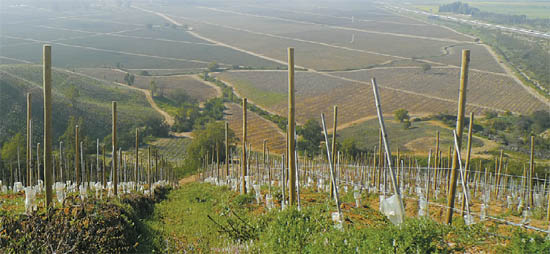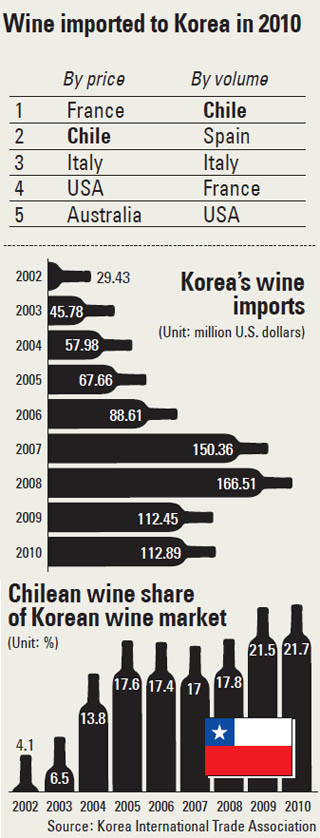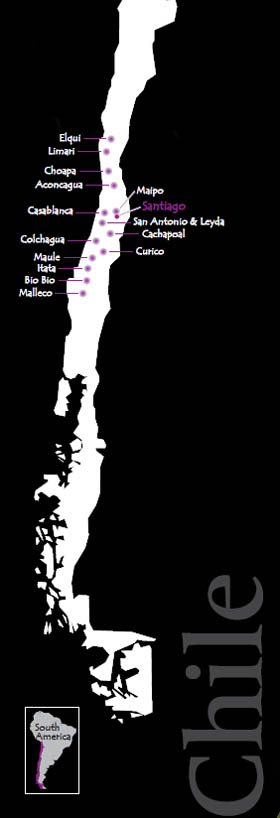Fine wine Chilean style

Casablanca Vineyard in central Chile. The vineyard produces Carolina wine. By Seo Ji-eun
Such moves by the partially state-run organization indicate the Latin American country has embarked on an aggressive marketing push in Asia, as its wineries have been striving to recover from the devastating earthquake a year and eight months ago. (Wine producers such as Undurraga and Siegel are still in the middle of rebuilding their damaged facilities, but the majority of wineries resumed international shipping less than a month after the earthquake.)
Chilean wines in Korea
“This year we are boosting promotion of our wines in Asia. In Korea, for example, we are hosting an Esquire Beauty Bar party later this year in addition to the WoC tasting and seminar,” Valenzuela said. “Next year, we are planning to double the marketing budget for the international market. It is going to be a very significant year.”
He noted the importance of the Korean wine market for Chile. “We have the biggest [sales] volume in Korea, even bigger than France, whereas in the neighboring China, local wines are still dominant. Now that the notion of Chilean wines has been firmly established in Korea, we intend to push premium wines further - by having wine drinkers there associate wine more with food. We aim to beat France in terms of prices as well.”
Although Korea imported less wine in 2009 and 2010 compared with two previous years - largely in the aftermath of the financial crisis in late 2008 - Chile was confident about its wine’s resilience in Korea. “Despite the economic downturn, regarding Korean market, I don’t think Chile is very concerned,” said Nicolas Pollman, export manager with Emiliana, a brand renowned for organic wines. “We want to raise the image and position we have now.”
Even though the two countries are more than a day apart by air, Korea has been a crucial wine-export partner for Chile, which ships 67 percent of wine it produces overseas. The two countries clinched a free trade agreement in April of 2004. Now Korea is the third-largest market for Chile, trailing the United States and Canada. “Proliferation of FTAs with many countries around the world is the main pillar of making Chilean wines global,” said Richard Sharman, representative of Wines of Chile.

What aspects of Chilean wines make them so attractive to Koreans? Kim Eun-ji, a spokeswoman with Nara Cellar, a Korean importer of Montes - a midsized wine producer but one of the most well-known Chilean wine labels among Koreans - pointed out consistent quality as well as reasonable price level when compared with their French counterparts. Unlike European wine-growing regions that mostly have volatile weather conditions, Chile has been blessed with wet winters and long, hot summers, which contribute to minimizing the risk of fluctuating wine quality each year.
Taste has also played a crucial role. “Koreans are used to intense taste due to the nature of chili- and garlic-charged traditional food and those entry-level wine drinkers seem to find Chilean wines’ strong tannin and intense fruity aroma fit their taste buds,” Kim said. “We are seeing persistent demand for Chilean wines from both entry-level drinkers and enthusiasts.”
For Chile, Korea is an interesting market in comparison with others. Although many Koreans prefer Chilean wines mainly because of their relatively reasonable prices coupled with convincing quality, Koreans do not necessarily go for the cheapest option, wineries said.
Pablo Miranda, export director for Asia at the VSPT Wine Group, the second-largest wine group in Chile, said only in Korea does 1865, a premium wine brand from the group’s San Pedro winery, sell the most, while Chilean local bestseller Gato Negro, which carries the lowest price tag, sells the least. In other overseas markets, the sales trend is entirely the opposite.
The 1865 brand is one of the most beloved wines in Korea - particularly among the golf-playing demographic in their 40s and 50s who are fascinated with the label’s marketing slogan implied in the naming: “Finish 18 holes with only 65 shots.” Coming in six red varieties - including Cabernet Sauvignon, Malbec, Carmenere and Syrah - 1865 wines sell at between 58,000 and 100,000 won ($50 and $88) at retail prices. The majority of Chilean wines imported to Korea carry price tags of 30,000 to 40,000 won.
Upbeat about the prospect of premium wines in Korea, Errazuriz, one of the leaders in wines of the sort, has recently made an unconventional decision for its icon wine Sena’s distribution in Korea. (Icon wine refers to a sort that involves best-quality handcraft, traceable history, particular terroir - the French word for the combination of geography, geology and other factors giving a vineyard its specific qualities - and recognition by prestigious wine experts.)

A blend of classic Bordeaux varieties, including Cabernet Sauvignon, Merlot and Carmenere, Sena is the result of collaboration that began in 1995 between Eduardo Chadwick, owner of Errazuriz, and the late Robert Mondavi, a world-famous California vineyard operator. Its 2001 vintage shocked the world as it was among two Chilean wines to take the top two places in the legendary Berlin Wine Tasting of 2004, a blind tasting of icon wines from France, Italy and Chile. Some of its expensive vintages sell at up to 300,000 won per bottle.
When asked about the impact of the July 1 implementation of the Korea-EU Free Trade Agreement on Chile’s wine industry, many wine industry insiders interviewed seemed hardly anxious. “We have big advantages over Europe,” said Carlos Serrano, export director with Montes.
Europe has played an indispensable part in the country’s wine history. Wine grapes arrived in Chile in the 1500s with the Spanish missionaries who needed wine to celebrate Catholic mass. Spanish winemaker Miguel Torres was the first to choose a valley in Chile to establish his winery in 1879, and others from France, Germany, Italy and California followed suit, forging partnerships with existing Chilean wineries.
But international trade of Chilean wines began only in the 1980s, when its government eased complicated and restrictive wine-sales policies, and the industry entered a booming period from the 1990s. On the back of brisk exports to around 150 destinations around the world over the past decade, Chile is now the world’s eighth-largest producer and the fifth-largest wine exporter - after Italy, France, Spain and Australia.
The country, in the Southern Hemisphere, has all the natural assets for growing quality grapes. It has three climate zones - hot, Mediterranean and cool - and valleys have diverse terrain, thus facilitating growth of many different varieties.
The wide gap between temperatures at night and during the day of up to 25 degrees Celsius contributes to the colors and aroma of the grapes. The country also takes pride in its signature grape Carmenere, a red variety originating from Bordeaux in France that had been thought lost to attacks from the phylloxera insect but was found alive and well in Chile in 1994. “European wineries have much more difficulty with disease, whereas we are quite isolated,” said Pollman of Emiliana.
Overcoming impending challenges
Despite its dazzling success in the past decades, Chile is now faced with high levels of competition against different world producers and the challenges of relatively low costs of its wines and rising production costs due to expensive labor.
In a move to tackle a series of difficulties, the country announced in December last year the 2020 goal of becoming No. 1 among New World wine-producing countries such as the United States, Argentina, New Zealand, Australia and South Africa.
Toward this goal, Chile has been seeking ways to differentiate its wines from its competitors. Many of wine producers, such as Cono Sur and Miguel Torres, have opted for organic farming, whereas Emiliana has pioneered biodynamic farming. Biodynamic farming is a practice similar to organic farming in that it avoids man-made chemical pesticides, fungicides and fertilizers in the vineyard. The new system also uses seasonal cycles and cosmic rhythms and promises higher billings on the products.
Undurraga, founded in 1885, launched a so-called “terroir hunter” project two years ago to search for small plots of land sized under five hectares (12.4 acres) based on the belief that there are distinct characteristics discernible in the wines from the different terroirs. It is part of an attempt to look more closely at wine-growing lands and identify which land produces better wines.
Given relatively lower recognition of sparkling wines from Chile, Valdivieso, the country’s No. 1 sparkling wine exporter, Undurraga and Miguel Torres believe sparkling wines can create a new niche market for Chile. “Chile has all the necessary conditions for sparkling wines. When the Spanish and French can do it, why not us? We don’t have the prestige but offer reasonable prices,” said Carolina Gomez, communications director with Undurraga.
By Seo Ji-eun [spring@joongang.co.kr]










with the Korea JoongAng Daily
To write comments, please log in to one of the accounts.
Standards Board Policy (0/250자)